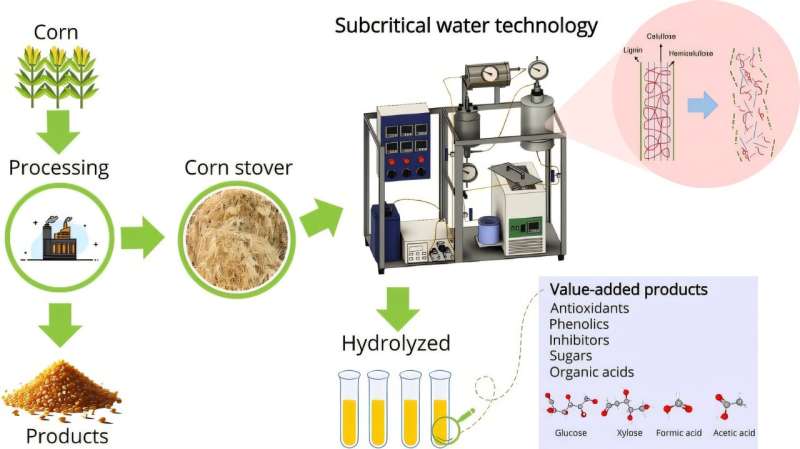
A recent study in the Biofuel Research Journal, conducted by teams from the State University of Campinas (UNICAMP) and the Federal Technological University of Paraná (UTFPR) in Brazil, explored how effectively corn stover can be used for creating bioderivatives while also assessing its environmental impact.
Corn stover, a plentiful leftover from farming, is largely ignored but contains valuable compounds like hemicellulose, cellulose, and lignin.
This research, led by doctoral student Rafael Gabriel da Rosa, successfully extracted sugars and organic acids that possess antioxidant, anti-inflammatory, and antimicrobial traits from this agricultural waste. They achieved this by using hydrolysis with “subcritical water”—hot water that is maintained just below boiling—instead of traditional acid hydrolysis, making the process more efficient. This innovation could benefit the food, pharmaceutical, and biofuel industries.
The yield of each by-product varies based on temperature and pH, starting from phenolic compounds, moving to sugars, and finally to organic acids.
The findings indicated a notable improvement: subcritical hydrolysis produced 16.06 to 76.82 milligrams of gallic acid equivalent per gram of corn stover, compared to only 12.76 milligrams with acid hydrolysis.
In terms of sugar extraction (including glucose, xylose, and cellobiose), the researchers achieved an impressive 448.54 milligrams per gram of stover when treated at 170 °C for 30 minutes at a pH of 1. Conventional methods only managed 74.5 milligrams, making this a six-fold increase in yield and a decrease in both time and energy use.
When it comes to organic acids like acetic and formic, they extracted 1,157.19 milligrams per gram at a higher temperature of 226 °C and a pH of 4.5. “This extraction presents a real opportunity for creating renewable chemical precursors for solvents and natural preservatives,” states Tânia Forster-Carneiro, co-author of the study and professor at UNICAMP’s School of Food Engineering (FEA).
A Green Solution
The research team also evaluated the sustainability of their method using a tool called EcoScale. This tool helps assess laboratory-scale chemical reactions in terms of their environmental, economic, and social impact.
EcoScale scores reactions on a scale of 0 to 100, with a score of 0 indicating a failed reaction and 100 representing a perfect reaction: where inexpensive starting materials yield high-quality outcomes at room temperature with minimal risk and environmental harm.
“We were thrilled to find that our method scored 93 points!” expresses Forster-Carneiro, especially when compared to other processes using harsher chemicals, which scored between 54.63 and 85.13 points.
Additionally, the study included a preliminary analysis of economic viability, considering factors like equipment costs and energy requirements. “This helps in strategic decision-making by simulating various scenarios and pinpointing the most promising options for industrial use,” explains Forster-Carneiro.
The focus of this research was primarily on sugar, which holds the most economic potential in biofuels, and the results indicated a payback period of about four to five years.
For more details:
Rafael Gabriel da Rosa et al, “Transforming corn stover waste into valuable bioproducts using subcritical water hydrolysis,” Biofuel Research Journal (2025). DOI: 10.18331/BRJ2025.12.1.2
If you would like to see similar Tech posts like this, click here & share this article with your friends!

